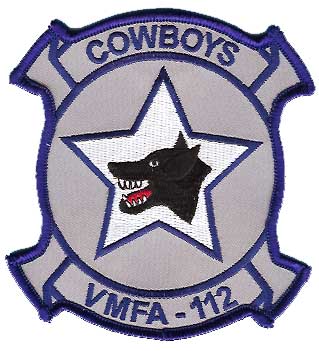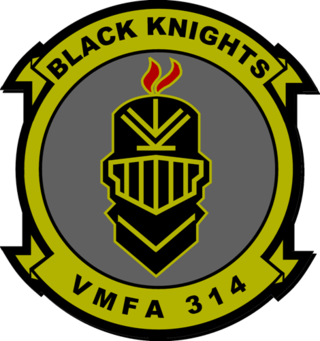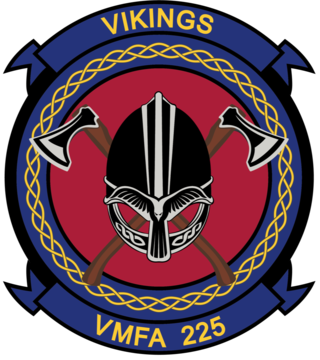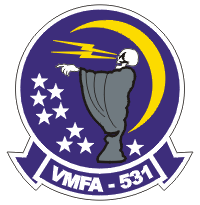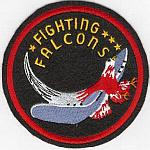Decommissioned squadrons
Squadrons are listed by their designation at the time they were decommissioned.
Pre–World War II squadrons
Following World War I, Marine aviation was significantly reduced from 8 to 3 squadrons. Many of the squadrons were renamed and re-designated numerous times and many still exist today with other designations. The squadrons listed below reflect those squadrons that were decommissioned prior to World War II and were never reconstituted in any form.

| Squadron Name | Insignia | Nickname | Date Decommissioned | Sources |
|---|---|---|---|---|
| VP-3M Marine Patrol Squadron 3 | | 1931 | [3] | |
| VO-6M Marine Observation Squadron 6 | | Hell Divers | 1932 | [3] |
| VO-10M Marine Observation Squadron 10 | | 1 April 1931 | [3] | |
| VS-14M Marine Scouting Squadron 14 | | 1 July 1933 | [3] | |
| VS-15M Marine Scouting Squadron 15 | | 1 July 1933 | [3] | |
| ZK-1M 1st Marine Barrage Balloon Squadron | | 31 December 1929 | [4] |
Marine Reserve Scouting Squadrons
The Marine Aviation Reserve was inactive from 1918 through 1928. [5] When it was reconstituted, the names and aircraft used by these squadrons changed frequently but their home duty stations remained constant. The aircraft for these squadrons were assigned to the reserve bases themselves and were shared with co-located Navy Reserve squadrons. [6] The squadrons were absorbed into the 1st and 2nd Marine Aircraft Wings and their identities lost when they were mobilized in December 1940. [3]
| Squadron Name | Insignia | Nickname | Location | Date Decommissioned | Source |
|---|---|---|---|---|---|
| VMS-1R | | Boston, Massachusetts | December 1940 | [6] | |
| VMS-2R | | Brooklyn, New York | December 1940 | [6] | |
| VMS-3R | | Anacostia, D.C. | December 1940 | [6] | |
| VMS-4R | | Miami, Florida | December 1940 | [6] | |
| VMS-5R | | Black Knights | Grosse Ile, Michigan | December 1940 | [7] |
| VMS-6R | | Minneapolis, Minnesota | December 1940 | [6] | |
| VMS-7R | | Long Beach, California | December 1940 | [6] | |
| VMS-8R | | Oakland, California | December 1940 | [6] | |
| VMS-9R | | Seattle, Washington | December 1940 | [6] | |
| VMS-10R | | Kansas City, Kansas | December 1940 | [6] | |
| VMS-11R | | Brooklyn, New York | December 1940 | [6] |
Marine Barrage Balloon Squadrons
Squadrons flying lighter than air vehicles (balloons), were indicated by the letter Z in naval squadron designation. [8] The first use of balloons by the Marine Corps was during World War I when they were used for artillery spotting. [9] After the outbreak of World War II, the Navy authorized the Marine Corps to create barrage balloon squadrons for the air defense of advanced naval bases. [10] Balloon training was cancelled in the summer of 1943 and the remaining units were decommissioned by the end of the year. [11]

| Squadron Name | Insignia | Nickname | Date Decommissioned | Source |
|---|---|---|---|---|
| ZMQ-1 | | 15 December 1943 | [12] | |
| ZMQ-2 | | 21 August 1943 | [12] | |
| ZMQ-3 | | 9 December 1943 | [13] | |
| ZMQ-4 | | 20 February 1943 | [12] | |
| ZMQ-5 | | 5 December 1943 | [12] | |
| ZMQ-6 | | 8 December 1943 | [12] |
Marine Balloon Observation Squadron
ZK-1M was formed in 1924 and disbanded in 1929.
Marine Scout Bombing Squadrons
Scout bombing squadrons each had eighteen to twenty-four Douglas SBD Dauntless dive bombers and were tasked with conducting dive-bombing attacks and long range scouting and patrol missions. They also provided close air support, laid smoke screens and sprayed DDT around bases. [14] The majority of these squadrons were quickly decommissioned following the end of World War II although three entered the Marine Air Reserve for a short period.
- SBD Dauntless
- SB2C Helldiver
|
|
Marine Torpedo Bombing Squadrons
VMTBs were torpedo bomber squadrons that operated the Grumman TBF Avenger. They were in service with the Marine Corps during World War II and were decommissioned shortly after the war. They were part of the Cactus Air Force on Guadalcanal, served on escort carriers during the campaign to retake the Philippines and provided close air support for Australian forces on Borneo and Marines during the Battle of Okinawa. [27]

| Squadron Name | Insignia | Nickname | Date Decommissioned | Source |
|---|---|---|---|---|
| VMTB-151 | | Ali Baba | 20 March 1946 | [28] [24] |
| VMTB-341 | | Torrid Turtles | 13 September 1945 | [29] |
| VMTB-454 | | Helldivers | 28 January 1946 | [30] |
| VMTB-621 | | 10 March 1945 | [31] | |
| VMTB-622 | | 31 January 1946 | [31] | |
| VMTB-623 | | 20 March 1946 | [31] | |
| VMTB-624 | | 10 March 1946 | [32] |
Marine Fighting Squadrons
Marine Fighting Squadrons were multirole squadrons responsible for air-to-air combat, combat air patrols, attacking enemy shipping, escorting bombers and close air support. [33] By far the most numerous of any type of Marine Corps squadron, they first made their mark flying the Grumman F4F Wildcat as part of the Cactus Air Force on Guadalcanal and finished World War II flying the venerable Vought F4U Corsair. Many VMF squadrons continued to operate after the war with most in the Marine Air Reserve; however, with the retirement of the Vought F-8 Crusader the VMF squadrons either became VMFAs or were decommissioned.
|
|
Marine Night Fighter Squadrons
After witnessing the Royal Air Force's success using radar directed fighters at night in 1941, [9] the Navy's Bureau of Aeronautics authorized eight Marine night fighter squadrons to be formed by 1945. [59] This timeline was brought forward considerably after the attack on Pearl Harbor and their need proven by the frustration of the Cactus Air Force's pilots not being able to engage Japanese bombers at night during the Battle of Guadalcanal. This led to the formation of VMF(N)-531 in November 1942. After much deliberation the Lockheed PV-1 Ventura was picked as the first choice of aircraft for these squadrons. The night fighting squadrons featured radar equipped aircraft, ground-based radar and personnel that provided Ground-controlled interception (GCI). The VMF(N) designated squadrons were decommissioned after the war, those that weren't were re-designated VMF(AW). [60]

| Squadron Name | Insignia | Nickname | Date Decommissioned | Source |
|---|---|---|---|---|
| VMF(N)-532 | | Night Fighters | 31 May 1947 | [31] |
| VMF(N)-534 | | 31 May 1947 | [31] | |
| VMF(N)-544 | | 20 April 1946 | [31] |
Marine Bombing Squadrons
The Marine Bombing Squadrons were formed during World War II to fill the need for a long range, land based bomber that could be used against enemy shipping and submarines. In the Pacific Theater, the squadrons served ashore as a garrison air force to attack bypassed Japanese bases and other installations. The VMBs flew the North American PBJ-1 Mitchell, which was the naval version of the U.S. Army Air Forces' B-25 Mitchell. Sixteen of these squadrons were commissioned with seven serving in combat, four never able to leave the U.S. due to the war ending and four others converted to VMTB squadrons. [61] The seven PBJ squadrons that saw combat in the Pacific suffered the loss of 45 aircraft, 26 in combat and 19 in non-combat operations, and 173 crew: 62 officers and 111 enlisted men. [62]

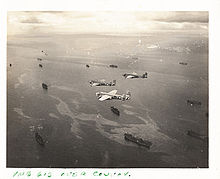
| Squadron Name | Insignia | Nickname | Date Decommissioned | Source |
|---|---|---|---|---|
| VMB-423 | Seahorses | 30 November 1945 | [63] | |
| VMB-433 |  | Fork-Tailed Devils | 30 November 1945 | [64] [63] |
| VMB-443 | Wildcats | 30 November 1945 | [63] | |
| VMB-453 | | 20 March 1946 | [30] | |
| VMB-473 | | 20 March 1946 | [30] | |
| VMB-483 | | 15 March 1945 | [65] | |
| VMB-612 | Cram's Rams | 14 March 1946 | [66] [24] | |
| VMB-613 | 21 November 1945 | [63] | ||
| VMB-614 | | Ruptured Ducks | 28 December 1945 | [31] |
Marine Operational Training Squadrons
All of these squadrons were activated as Marine Training Squadrons (MTS) at Marine Corps Air Station Edenton, North Carolina in January 1944 and were redesignated as Marine Operational Training Squadrons (MOTS) and transferred to Marine Corps Air Station Cherry Point, North Carolina in February 1945 as medium bomber pilot training units. They instructed Marines learning to fly the North American PBJ-1 Mitchell. Following the end of the war they were quickly decommissioned. [67]
| Squadron Name | Insignia | Nickname | Date Decommissioned | Source |
|---|---|---|---|---|
| MOTS-811 | | 10 September 1945 | [68] [24] | |
| MOTS-812 | | 10 September 1945 | [68] [24] | |
| MOTS-813 | | 23 November 1945 | [68] [24] | |
| MOTS-814 | | 30 November 1945 | [68] [24] |
Marine Photographic Squadrons
Marine photographic squadrons were first formed in 1942 and went through numerous name changes while they were active. VMDs/VMPs flew photographic modified versions of the Douglas SBD Dauntless, Consolidated PB4Y-1 Liberator, Consolidated PB4Y-2 Privateer and Grumman F7F Tigercat. The main mission of these squadrons was to conduct long range, very high-altitude photographic reconnaissance. [69]

| Squadron Name | Insignia | Nickname | Date Decommissioned | Source |
|---|---|---|---|---|
| VMD-154 | | Pathfinders | 10 September 1945 | [70] [24] |
| VMP-254 | | 30 November 1949 | [71] | |
| VMP-354 | | 8 December 1949 | ||
| VMD-954 |  | 31 January 1946 | [26] [24] |
Marine Glider Squadron
The Marine Corps established a glider program in April 1942. Eventually they set goals of having 10,800 Marines qualified as glider infantry, with 1,371 gliders and 3,436 pilots. [72] They originally operated from Page Field on MCRD Parris Island but later moved to Marine Corps Air Station Eagle Mountain Lake outside Dallas, Texas. [73] The program was disbanded in 1943 when it was determined that glider assaults into small, heavily fortified, jungle islands would be tactically unfeasible. [74]

| Squadron Name | Insignia | Nickname | Date Decommissioned | Source |
|---|---|---|---|---|
| VML-711 | | 24 May 1943 | [75] |
Marine Transport Squadrons
Flying the Douglas R4D Skytrain and the Curtiss R5C-1 Commando, these squadrons were responsible for moving troops and cargo, aerial resupply, delivery of Paramarines, and medical evacuation.

| Squadron Name | Insignia | Nickname | Date Decommissioned | Source |
|---|---|---|---|---|
| VMR-152 | | 31 January 1959 | ||
| VMR-216 | Bull Dogs | 21 December 1972 | [76] | |
| VMR-353 | | 15 February 1946 | [77] | |
| VMR-952 | | 31 May 1947 | [78] | |
| VMR-953 | | Puss in Boots | 31 May 1947 | [32] |
Marine Scouting Squadrons
There were three Marine Scouting Squadrons prior to World War II; however, VMS-3 was the only squadron to retain the designation. The squadron served in Haiti from 1919 through 1934 and then spent its last ten years at St. Thomas, Virgin Islands. During World War II they were the only Marine Corps squadron to operate east of the United States. They began the war flying the Grumman J2F Duck, transitioned to the Naval Aircraft Factory/Vought OS2N Kingfisher and at the time of deactivation were flying SBD Dauntless dive bombers. [69]

| Squadron Name | Insignia | Nickname | Date Decommissioned | Source |
|---|---|---|---|---|
| VMS-3 | | Devilbirds | 20 May 1944 | [79] |
Marine Target Towing Detachments
Marine Target Towing detachments were first formed at Marine Corps Air Station Ewa in October 1944. They were responsible for towing targets for antiaircraft gunnery and radar tracking practice. They flew Martin JM-1 Marauders and the Curtiss R5C-1 Commandos. The last of these detachments was decommissioned in March 1946. [80]

| Squadron Name | Insignia | Nickname | Date Decommissioned | Source |
|---|---|---|---|---|
| VMJ-1 | | October 1945 | ||
| VMJ-2 | | 6 March 1946 | [81] | |
| VMJ-3 | | Red Asses | 21 October 1945 | [79] |
Marine Observation Squadrons
The Marine observation squadrons were formed during the latter stages of World War II with the primary mission of forward air control of strike aircraft for close air support and air interdiction. [82] They saw extensive service during the Vietnam War flying the North American OV-10 Bronco. The Marine Corps began decommissioning the VMO squadrons following their participation in Operation Desert Storm as turboprop-driven aircraft were being perceived in the wake of that conflict as being too vulnerable to surface-to-air missiles, especially shoulder-launched man-portable air defense systems (MANPADS), to fly over modern battlefields. Their mission has been assumed by the VMFA(AW) squadrons flying the F/A-18D Hornet.

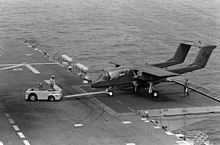
| Squadron Name | Insignia | Nickname | Date Decommissioned | Source |
|---|---|---|---|---|
| VMO-1 | | 31 July 1993 | ||
| VMO-2 | | Cherry Deuce | 20 May 1993 | |
| VMO-4 | | Evil Eyes | 31 March 1994 | |
| VMO-6 | | Tomcats | 1 January 1976 | [83] [84] |
| VMO-7 | | 16 November 1945 | ||
| VMO-8 | | July 1976 | ||
Marine Attack Squadrons
In 1951, the Marine Corps began fielding the Douglas AD-1 Skyraider ground attack aircraft which had as its main role close air support for the Marines on the ground. Thus many squadrons had their designation changed from VMF to VMA to reflect this ground attack role. 13 squadrons were equipped with the Skyraider until they were finally phased out in 1958. [85] Follow on VMA squadrons operated the A-4 Skyhawk during the Vietnam War through their retirement just after Operation Desert Storm. The VMA tradition is carried on today by squadrons flying the AV-8B Harrier II.



| Squadron Name | Insignia | Nickname | Date Decommissioned | Source |
|---|---|---|---|---|
| VMA-131 | | Diamondbacks | 5 December 1998 | [86] |
| VMA-133 | | Dragons | 30 September 1992 | |
| VMA-141 | | 1 September 1969 | [87] | |
| VMA-143 | | Rocket Raiders | 30 June 1962 | [88] |
| VMA-144 | | Hensagliska | 31 October 1965 | [89] |
| VMA-217 | | Max's Wild Hares | 1964 | |
| VMA-233 | | Flying Deadheads | 1 July 1969 | [87] |
| VMA-236 | | Black Panthers | 31 August 1962 | [90] |
| VMA-241 | | Sons of Satan | 1 October 1969 | [87] |
| VMA-322 | | Fighting Gamecocks | 27 June 1992 | [91] |
| VMA-324 | | Devildogs | 29 August 1974 | [92] |
| VMA-331 | | Bumblebeess | 1 October 1992 | |
| VMA-543 | | Night Hawks | 1 April 1974 | [93] |
| VMA-611 | | 1 March 1969 | [87] |
Marine Tactical Electronic Warfare Squadrons
VMAQ squadrons operated the EA-6B Prowler [94] and were tasked with providing electronic attack, electronic counter-countermeasures, radar jamming and suppression of enemy air defense using the AN/ALQ-99 jamming pod [95] and the AGM-88 HARM. Each of the four squadrons operated five aircraft and were land-based, although they were capable of landing on board U.S. Navy aircraft carriers. [96] [97] VMAQ-2 decommissioned on 8 March 2019 marking the end of active service for the VMAQs and the EA-6B Prowler.
| Squadron Name | Insignia | Nickname | Date Decommissioned | Source |
|---|---|---|---|---|
| VMAQT-1 | | Banshees | 29 April 2016 | [98] |
| VMAQ-2 | | Death Jesters | 8 March. 2019 | [99] |
| VMAQ-3 | | Moon Dogs | 11 May 2018 | [100] |
| VMAQ-4 | | Seahawks | 2 June 2017 | [101] |
Marine Reconnaissance Squadron
Marine Reconnaissance Squadron 4 was the only reserve photographic reconnaissance squadron in the Marine Corps. Initially based in Naval Air Station New Orleans, Louisiana they moved to Naval Air Station Olathe, Kansas 1 May 1967 and then again to Naval Air Station Dallas, Texas in 1970 when the reserves were reorganized. They flew Vought RF-8A Crusader until 1969 when all the planes were replaced with the Vought RF-8G Crusader. [102]

| Squadron Name | Insignia | Nickname | Date Decommissioned | Source |
|---|---|---|---|---|
| VMJ-4 | | 1973 |
Marine Composite Reconnaissance Squadrons
Following the Korean War Marine Composite Squadron 1 (VMC-1) and Marine Photographic Squadron 1 (VMJ-1) were combined to form VMCJ-1. The new squadron was responsible for both Photoreconnaissance and Electronic Warfare. In its early years it flew the Vought RF-8A Crusader and Douglas EF-10B Skyknight but these were later replaced by the McDonnell-Douglas RF-4B Phantom II and the Grumman EA-6A Electric Intruder. The squadron was decommissioned following the end of the Vietnam War and the reorganization of the Marine Corps' composite community in 1975.
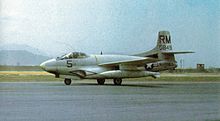
| Squadron Name | Insignia | Nickname | Date Decommissioned | Source |
|---|---|---|---|---|
| VMCJ-1 | | Golden Hawks | 1 September 1975 | [103] |
Marine Tactical Reconnaissance Squadron
Upon the decommissioning of the Marine Composite Squadrons (VMCJs), VMFP-3 became the lone photographic reconnaissance squadron in the Marine Corps. [104] They flew the McDonnell-Douglas RF-4B Phantom II and operated from 1975 until being decommissioned in 1990. Their capability has since been replaced by various targeting pods used on Marine aircraft and the Advanced Tactical Airborne Reconnaissance System which is found in some of the McDonnell-Douglas F/A-18 Hornet squadrons. [105]

| Squadron Name | Insignia | Nickname | Date Decommissioned | Source |
|---|---|---|---|---|
| VMFP-3 | | Eyes of the Corps | 3 September 1990 |
Marine Fighter Attack Squadrons
The first Marine Corps squadron to be redesignated a VMFA was in June 1962 upon receipt of the first McDonnell-Douglas F-4 Phantom II aircraft. VMF and VMA squadrons were redesignated because the new Phantoms could be both fighter aircraft and ground attack aircraft. [106] These squadrons were heavily deployed during the Vietnam War. Most of these squadrons would eventually convert to the McDonnell-Douglas F/A-18 Hornet with the last F-4 Phantom leaving service in 1992. [107] The end of the Cold War saw the deactivation of some VMFA squadrons as part of the overall drawdown of the US Military [108]

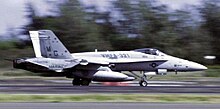
| Squadron Name | Insignia | Nickname | Date Decommissioned | Source |
|---|---|---|---|---|
| VMFA-115 |  | Silver Eagles | 9 November 2023 | [109] |
| VMFA-124 | | Whistling Death | 19 June 1999 | [110] |
| VMFA-134 | | Smoke | 1 April 2007 | [111] |
| VMFA-142 | | Gators | July 2008 | [112] |
| VMFA-212 |  | Lancers | 11 March 2008 | [113] |
| VMFA-235 | | Death Angels | 14 June 1996 | [114] |
| VMFA-251 | | Thunderbolts | 23 April 2020 | [115] |
| VMFA-321 | | Hells Angels | 30 September 2004 | [116] |
| VMFA-333 | | Fighting Shamrocks | 31 March 1992 | [117] |
| VMFA-334 | | Falcons | 30 December 1971 | [118] |
| VMFA-351 | | 1978 | [119] | |
| VMFA-531 | | Grey Ghosts | 27 April 1992 | [120] |
Marine All-Weather Fighter Attack Squadron
| Squadron Name | Insignia | Nickname | Date Decommissioned | Source |
|---|---|---|---|---|
| VMFA(AW)-332 |  | Moonlighters | 30 March 2007 | [121] |
Marine Heavy Helicopter Squadrons

| Squadron Name | Insignia | Nickname | Date Decommissioned | Source |
|---|---|---|---|---|
| HMH-463 | | Pegasus | 22 April 2022 | [122] |
| HMH-366 | | Hammerheads | 16 December 2022 | [123] |
| HMH-769 | | Titan | 2 August 2008 | [124] |
| HMH-777 | | Flying Armadillos | 1980 | [125] |
Marine Medium Helicopter Squadrons
The original Marine Medium Helicopter squadrons flew the Sikorsky UH-34D Sea Horse, which shortly after its inception saw extensive combat during the Vietnam War. [126] Beginning in 1966 they began to be replaced with the CH-46 Sea Knight which was faster, could carry more troops and is still in service today. [127] The decommissioned HMM squadrons reflect the UH-34D training squadron and various reserve squadrons.

| Squadron Name | Insignia | Nickname | Date Decommissioned | Source |
|---|---|---|---|---|
| HMM-761 | | 31 August 1962 | [128] | |
| HMM-762 | | 31 December 1962 | [129] | |
| HMM-763 | | 30 September 1962 | [130] | |
| HMM-766 | | Beavers | 1 October 1976 | [131] |
| HMM-768 | | 1976 | [132] |
Marine Light Helicopter Squadrons
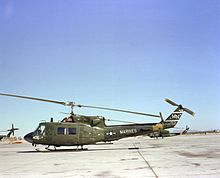
| Squadron Name | Insignia | Nickname | Date Decommissioned | Source |
|---|---|---|---|---|
| HML-765 |  | 30 June 1976 | [133] | |
| HML-767 | | Nomads | 1 August 1994 | [134] |
| HMM-770 | | Stingers | 1980 | [135] |
| HML-771 | | Hummers | 1 August 1994 | [134] |
| HML-776 | | Gangsters | 1 July 1994 | [134] |
Marine Light Attack Helicopter Squadrons
The Marine Corps’ light attack squadrons (HMLAs) are composite squadrons usually made up of 12 Bell AH-1Z Cobras and 6 Bell UH-1Y Hueys. The primary missions of the Cobra is close air support, forward air control, reconnaissance and armed escort, while the Huey provided airborne command and control, utility support, supporting arms coordination and medical evacuation. These squadrons were first formed during the Vietnam War with the fielding of the Bell AH-1 Cobra gunship and its being combined in the same squadron with the UH-1H Iroquois that initially belonged to the Marine Corps' VMO squadrons. The majority of these squadrons are still active in the Fleet Marine Force today.
| Squadron Name | Insignia | Nickname | Date Decommissioned | Source |
|---|---|---|---|---|
| HMLA-269 | | The Gunrunners | 9 December 2022 | [136] |
| HMLA-467 |  | Sabers | 16 June 2016 | [137] |
| HMLA-469 | | Vengeance | 16 December 2022 | [138] |
Marine Medium Tiltrotor Squadron
Marine tiltrotor squadrons operate the MV-22 Osprey with their main mission being assault support. The Osprey offers twice the speed, five times the range, and can fly more than twice as high as the CH-46 Sea Knight it replaced. The Marine Corps has 18 operational Osprey squadrons as of April 2018.
| Squadron Name | Insignia | Nickname | Date Decommissioned | Source |
|---|---|---|---|---|
| VMM-166 | | Sea Elk | 1 October 2021 | [139] |
| VMM-264 | | Black Knights | 24 June 2020 | |
| VMM-561 | | Pale Horses | 7 July 2012 |
Training squadrons



| Squadron Name | Insignia | Nickname | Date Decommissioned | Source |
|---|---|---|---|---|
| VMAT-20 Marine Attack Training Squadron | | |||
| VMFAT-101 Marine Fighter Attack Training Squadron | | Sharpshooters | 29 September 2023 | [141] |
| VMAT-102 Marine Attack Training Squadron | | Skyhawks | 1 October 1987 | |
| VMT-103 Marine Training Squadron | | Sky Chickens | 31 May 1972 | [142] |
| VMFAT-201 Marine Fighter Attack Training Squadron | | Hawks | 30 September 1974 | [143] |
| VMAT(AW)-202 Marine All-Weather Attack Training Squadron | | Double Eagles | 1990 | |
| VMAT-203 Marine Attack Training Squadron |  | Hawks | 29 October 2021 | [144] |
| VMGRT-253 Marine Aerial Refueler Transport Training Squadron |  | Titans | 14 September 2006 | |
| HMT-301 Marine Helicopter Training Squadron | | Windwalkers | 3 June 2005 | [145] |
| HMHT-401 Marine Heavy Helicopter Training Squadron | | 1 May 1972 | [146] | |
| HMMT-402 Marine Medium Helicopter Training Squadron | | 1 May 1972 | [146] |











